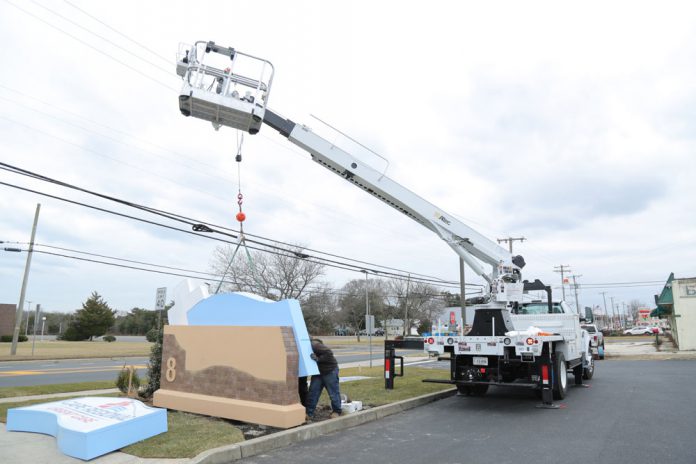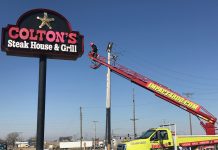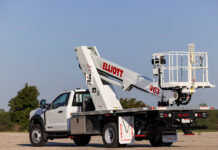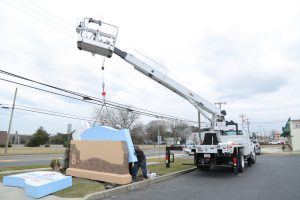 In the sign industry, crane trucks and aerial lifts are most generally utilized to perform sign maintenance or sign installation,” says Jerry Monahan, Western Regional business manager at Manitex. “Smaller trucks that are more compact and can be set up in smaller spaces are designed to cater to sign maintenance, while the larger units with heavier lifting capabilities can be used for both construction and maintenance.”
In the sign industry, crane trucks and aerial lifts are most generally utilized to perform sign maintenance or sign installation,” says Jerry Monahan, Western Regional business manager at Manitex. “Smaller trucks that are more compact and can be set up in smaller spaces are designed to cater to sign maintenance, while the larger units with heavier lifting capabilities can be used for both construction and maintenance.”
Many other industries use crane and aerial truck products as well—including construction, utilities, airports, amusement parks, and mining and oil refineries—so a sign company could also supplement a down market with any job a crane company would typically do. “The capacities need to be maintained, but some examples would be an air-conditioning installation, roof truss handling, and cargo moving,” suggests Mark Kruger, Altec Lights and Signs sales manager.
Three keys to efficient operation of crane trucks on the job site are planning, safety, and weight capacity.
“Pre-lift planning is essential to safe lifting operations,” says Phil Doud, Altec Sentry Trainer. “In addition to helping operators stay within lift capacity values, proper lift planning can help identify the best place to set up the crane and avoid time-consuming unit relocations during the job.”
Doud points out workers should avoid any hazards found during the survey. “Energized power lines or components are a particular concern, since there is usually some electrical component on or near the work area,” he says. “OSHA requires that cranes maintain a twenty-foot clearance from energized conductors (up to 50kV).”
Personnel safety is another critical factor. If personnel will be working in an elevated location, Doud stresses the importance of properly inspecting, wearing, and attaching their personal fall protection equipment to an appropriate fall arrest or restraint anchor point. “Always use rigging and slings that are in good condition, have legible manufacturer’s capacity tags attached, and have been inspected prior to use,” he says. “Never exceed the capacity of any rigging.”
Equipment providers are required to include capacity limits on their products, and it’s critical, both for the success of a sign installation project and the safety of the installers, that the weight of the load is properly gauged beforehand.
“The most accurate and efficient method of accomplishing this is to acquire a dynamometer to weigh the load to be lifted so that the load chart on the crane can be properly interpreted and utilized,” suggests Monahan.
Doud urges operators to not exceed capacity at any point. “The result could be crane instability, structural damage, or both,” he says.
Pylon Structures
Crane trucks are often used for installing signage onto tall, freestanding pylon structures. In these situations, careful attention to the jobsite will help to prevent costly delays or damage.
“Set up as close to the structure as possible and ensure there are no overhead obstructions,” recommends Monahan. “Make sure the surface you’re setting up on is solid and that you’re able to level the crane.
“Use approved cribbing beneath the outriggers leveling on uneven or soft ground and always use tag lines on each end of the load so that personnel on the ground can stabilize the load and help set it in place.”
As with any outdoor crane operation, weather can be a factor to consider as well. “Check that wind gusts are within allowable parameters according to the manufacturer,” adds Monahan. “If there are high wind gusts or lightning in the area, the lifting activity should be suspended until the weather clears.”
Open Spaces
Installing signage with crane trucks over open spaces can present its own unique challenges.
“Set up as close to the building front as possible and ensure there are no overhead obstructions,” recommends Monahan. “Make sure the surface you’re setting up on will support the weight of the truck. Avoid placing outriggers on sidewalks.”
An additional consideration is the danger of personnel or other foot traffic underneath the work area. “Never lift loads over personnel or allow personnel to enter the ‘fall zone’ where a falling load could injure or kill them,” says Doud.
Monahan suggests properly setting up an exclusion zone to prevent unauthorized people from entering the area where lifting operations are taking place.
Enclosed Spaces
All of the preceding recommendations remain valid for working in enclosed spaces as well—with a few extra precautions.
Having a working knowledge of the machine’s protection system is crucial to working in tight spaces. “Make sure that all electrical hazards have been locked out or covered up and be aware of any possible obstructions or collision areas,” says Kruger.
“Always use a spotter when any part of the boom or load is obstructed from the operator’s view,” says Monahan. “Consider using a radio to facilitate safe and proper communication between the spotter and operator.”
New Crane Rules
Crane trucks have received a lot of attention in the sign industry in recent months, as new OSHA crane operator certification requirements have been passed down and come into effect after lengthy delays.
The new OSHA requirements could impact many shops that are already using cranes. “If the crane is performing construction work and has a maximum manufacturer-rated capacity above 2,000 pounds, then the operator would need to comply with the operator certification requirements,” says Matthew Shaw, program coordinator, Regulatory Affairs and Test Development with the National Commission for the Certification of Crane Operators (NCCCO). “In jurisdictions where a state or city license is not required, this would mean possessing a valid accredited operator certification. If the jurisdiction does mandate licensure that meets OSHA’s criteria, then the operator must hold that license.”
Additional requirements are set to come into effect in early 2019. “By February 7, 2019, the employer is required to assess the operator’s ability to safely operate the equipment via newly established evaluation requirements and also document this evaluation,” says Shaw. “The documentation of the evaluation must be available at the worksite.
“If there’s any evidence that the employee requires retraining, the employer must provide this additional training,” adds Shaw.
Monahan says many large sign companies already have a certification program in place, so the OSHA rule shouldn’t affect them much. “Companies that don’t have certified operators will be required to utilize one of the OSHA-recognized certification organizations available to ensure that their operator is qualified to operate a lifting device that is rated for lifting more than 2,000 pounds,” he says.
Some owners choose to “de-rate” their crane so the rated capacity is less than 2,000 pounds. “This may mean operator certification is not required, but there are still OSHA crane standards that apply after de-rating,” says Doud, noting these requirements include signal person qualification, availability of instruction/operator manuals, and unit inspections, among several others. (Note: The requirements for cranes with hoisting capacity under 2,000 pounds are described in OSHA Standard 1926.1441.)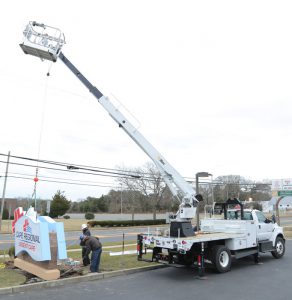
“Employers should always be aware of any additional crane licensing requirements imposed by the state or local jurisdictions they’re working in,” adds Doud. “We recommend they contact those authorities directly to discuss specifics, rather than rely on word of mouth or internet searches.”
The purpose of the OSHA Operator Certification rule is to ensure that a qualified person is operating the lifting device. “While the certification process may be viewed as a hinderance to some in the form of additional costs, it can pay off in the long run by helping to prevent accidents caused by misuse of their equipment,” says Monahan.
By Jim Cirigliano
All photos: Altec


